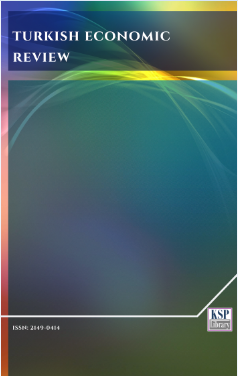Mathematics of Predicting Growth
Abstract
Abstract. Mathematical methods of analysis of data and of predicting growth are discussed. The starting point is the analysis of the growth rates, which can be expressed as a function of time or as a function of the size of the growing entity. Application of these methods is illustrated using the world economic growth but they can be applied to any type of growth.
Keywords. Growth rate, Differential equations, Gross Domestic Product, Economic growth.
JEL. C01, C20, C50, C53, C60, C65, C80
References
Ashraf, Q. H. (2009). Essays on Deep Determinants of Comparative Economic Development. Ph.D. Thesis, Department of Economics, Brown University, Providence.
Artzrouni, M., & Komlos, J. (1985). Population Growth through History and the Escape from the Malthusian Trap: A Homeostatic Simulation Model. Genus, 41, 21-39.
Baum, D. (2011). Oded Galor: Economic Growth Process over 100,000 Years. http://news.brown.edu/features/2011/06/galor
Galor, O. (2005a). From stagnation to growth: Unified Growth Theory. In P. Aghion& S. Durlauf (Eds.), Handbook of Economic Growth (pp. 171-293). Amsterdam: Elsevier.
Galor, O. (2005b). The Demographic Transition and the Emergence of Sustained Economic Growth. Journal of the European Economic Association, 3, 494-504. doi. 10.1162/jeea.2005.3.2-3.494
Galor, O. (2007). Multiple Growth Regimes—Insights from Unified Growth Theory. Journal of Macroeconomics, 29(3), 470-475. doi. 10.1016/j.jmacro.2007.06.007
Galor, O. (2008a). Comparative Economic Development: Insight from Unified Growth Theory. http://www.econ.brown.edu/faculty/Oded_Galor/pdf/Klien%20lecture.pdf
Galor, O. (2008b). Economic Growth in the Very Long Run. In: Durlauf, S.N. and Blume, L.E., Eds., The New Palgrave Dictionary of Economics, New York: Palgrave. doi. 10.1057/9780230226203.0434
Galor, O. (2008c). Comparative Economic Development: Insight from Unified Growth Theory. http://www.econ.brown.edu/faculty/Oded_Galor/pdf/Klien%20lecture.pdf
Galor, O. (2010). The 2008 Lawrence R. Klein Lecture—Comparative Economic Development: Insights from Unified Growth Theory. International Economic Review, 51, 1-44. doi. 10.1111/j.1468-2354.2009.00569.x
Galor, O. (2011). Unified Growth Theory.Princeton, New Jersey: Princeton University Press.
Galor, O. (2012a). Unified Growth Theory and Comparative Economic Development. http://www.biu.ac.il/soc/ec/students/mini_courses/6_12/data/UGT-Luxembourg.pdf
Galor, O. (2012b). The Demographic Transition: Causes and Consequences. Cliometrica, 6(1), 1-28. doi. 10.1007/s11698-011-0062-7
Galor, O. (2012c). Unified Growth Theory and Comparative Economic Development. http://www.biu.ac.il/soc/ec/students/mini_courses/6_12/data/UGT-Luxembourg.pdf
Galor, O., & Moav, O. (2002). Natural Selection and the Origin of Economic Growth. The Quarterly Journal of Economics, 117, 1133-1191. doi. 10.1162/003355302320935007
Johansen, A., & Sornette, D. (2001). Finite-time singularity in the dynamics of the world population, economic and & financial indices. Physica A, 294, 465–502.
Korotayev, A., Malkov, A., & Khaltourina, D. (2006a). Introduction to Social Macrodynamics. Compact Macromodels of the World System Growth. Moscow: URSS Publishers.
Korotayev, A., Malkov, A. & Khaltourina, D. (2006b). Introduction to Social Macrodynamics: Secular Cycles and Millennial Trends. Moscow: KomKniga/URSS
Korotayev, A. (2005). A Compact Macromodel of World System Evolution. Journal of World-Systems Research, 11(1), 379-393.
Lagerlöf, N-P. (2003). From Malthus to Modern Growth: Can Epidemics Explain Three Regimes? International Economic Review, 44, 755-777. doi. 10.1111/1468-2354.t01-1-00088
Nielsen, R. W. (2011). Construction and Maintenance of a Stratospheric Albedo Enhancing Shield. http://www.scribd.com/doc/46994144/RonNielsen-StratosphericShield
Nielsen, R. W. (2014). Changing the Paradigm. Applied Mathematics, 5(13), 1950-1963. doi. 10.4236/am.2014.513188
Nielsen, R. W. (2016a). Mathematical Analysis of the Historical Economic Growth, Journal of Economics Library, 3(1), forthcoming.
Nielsen, R. W. (2016b). Demographic Transition Theory Contradicted Repeatedly by Data, Journal of Economics and Political Economy, 3(1), forthcoming.
Snowdon, B., & Galor, O. (2008). Towards a Unified Theory of Economic Growth. World Economics, 9, 97-151.
Statistics Sweden (1999). Population development in Sweden in a 250-year perspective. Stockholm: Statistics Sweden. http://www.scb.se/Grupp/Hitta_statistik/Historisk_statistik/_Dokument/Befolkningsutvecklingen_under_250_ar_Historisk_statistik_1700talet_1800talet_1900talet.pdf
von Foerster, H., Mora, P., & Amiot, L. (1960). Doomsday: Friday, 13 November, A.D. 2026. Science, 132, 1291-1295.
World Bank (2015). GDP Statistics from the World Bank, http://knoema.com/mhrzolg/gdp-statistics-from-the-world-bank
DOI: http://dx.doi.org/10.1453/ter.v2i4.527
Refbacks
- There are currently no refbacks.
.......................................................................................................................................................................................................................................................................................................................................
Turkish Economic Review - Turk. Econ. Rev. - TER - www.kspjournals.org
ISSN: 2149-0414
Editor: [email protected] Secretarial: [email protected] Istanbul - Turkey.
Copyright © KSP Library




